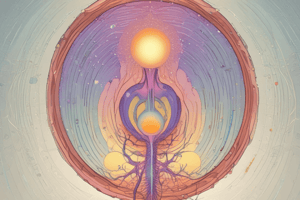Podcast
Questions and Answers
Which nutrient is transported through facilitated diffusion in the placenta?
Which nutrient is transported through facilitated diffusion in the placenta?
- Water
- Amino acids
- Fatty acids
- Glucose (correct)
What is the primary function of the chorionic membrane?
What is the primary function of the chorionic membrane?
- It serves as the respiratory surface for gas exchange. (correct)
- It fuses with the basal layer to support nutrient transfer.
- It partitions the amniotic fluid from the maternal blood supply.
- It initiates the development of the yolk sac.
Which hormone is not produced by the placenta?
Which hormone is not produced by the placenta?
- Human chorionic gonadotropin
- Testosterone (correct)
- Prolactin
- Oestrogen
Which layer develops into the amnion?
Which layer develops into the amnion?
What is the role of the amniochorionic membrane?
What is the role of the amniochorionic membrane?
What occurs within 12 hours after ovulation?
What occurs within 12 hours after ovulation?
What is formed from the inner cell mass of the blastocyst?
What is formed from the inner cell mass of the blastocyst?
During implantation, what does the trophoblast differentiate into?
During implantation, what does the trophoblast differentiate into?
What is the role of the decidua following implantation?
What is the role of the decidua following implantation?
What is the initial stage of zygote division after fertilization?
What is the initial stage of zygote division after fertilization?
What forms the primary villus in the chorionic structure?
What forms the primary villus in the chorionic structure?
How long does the implantation process take?
How long does the implantation process take?
What is the role of mesenchymal cells in the development of secondary villi?
What is the role of mesenchymal cells in the development of secondary villi?
What type of blood vessels are formed from the chorionic mesoderm?
What type of blood vessels are formed from the chorionic mesoderm?
What does the syncytiotrophoblast do during the formation of the placenta?
What does the syncytiotrophoblast do during the formation of the placenta?
What structure covers the blastocyst during embryo development?
What structure covers the blastocyst during embryo development?
What structure is formed by the distal part of the anchoring villi?
What structure is formed by the distal part of the anchoring villi?
How does maternal blood enter the intervillous spaces?
How does maternal blood enter the intervillous spaces?
What happens to chorionic villi during pregnancy?
What happens to chorionic villi during pregnancy?
When does the placenta achieve its definitive form?
When does the placenta achieve its definitive form?
What do the umbilical arteries carry?
What do the umbilical arteries carry?
Flashcards
Fertilization location
Fertilization location
Occurs in the fallopian tube's ampulla.
Zygote formation
Zygote formation
The fusion of male and female pronuclei, creating a single cell with 46 chromosomes.
Implantation time
Implantation time
Blastocyst burrows into the uterine wall (endometrium) roughly 7-8 days after fertilization.
Placenta origin
Placenta origin
Signup and view all the flashcards
Implantation process
Implantation process
Signup and view all the flashcards
Decidua formation
Decidua formation
Signup and view all the flashcards
Placenta function
Placenta function
Signup and view all the flashcards
Morula stage
Morula stage
Signup and view all the flashcards
Chorion
Chorion
Signup and view all the flashcards
Amnion
Amnion
Signup and view all the flashcards
Yolk Sac
Yolk Sac
Signup and view all the flashcards
Fetal Membranes
Fetal Membranes
Signup and view all the flashcards
Chorionic Villi Formation
Chorionic Villi Formation
Signup and view all the flashcards
Intervillous Spaces
Intervillous Spaces
Signup and view all the flashcards
Placental Membrane
Placental Membrane
Signup and view all the flashcards
Umbilical Cord Vessels
Umbilical Cord Vessels
Signup and view all the flashcards
Placenta Development
Placenta Development
Signup and view all the flashcards
Anchoring Villi
Anchoring Villi
Signup and view all the flashcards
Trophoblast Turnover
Trophoblast Turnover
Signup and view all the flashcards
Placental Structure
Placental Structure
Signup and view all the flashcards
Study Notes
Fertilization
- Fertilization occurs in the ampulla of the fallopian tube.
- It happens within 12 hours of ovulation.
- The process takes 24 hours.
- Sperm penetrates the corona radiata and zona pellucida, then attaches to the ovum's membrane.
- The zona prevents further sperm entry.
- The ovum completes its second maturation division, forming a female pronucleus.
- The sperm's tail degenerates, and the head forms the male pronucleus.
- The male and female pronuclei fuse, creating a zygote with 46 chromosomes.
Zygote Development
- The zygote divides.
- 2 cells are present 30 hours after fertilization.
- 16 cells (morula) develop on day 3 after fertilization.
- The morula develops into a blastocyst, a fluid-filled structure.
- The blastocyst has an inner cell mass (embryo + amnion) and a trophoblast (placenta + chorion).
Implantation
- The morula enters the uterine cavity on the third day.
- The endometrium or uterine lining develops, and progesterone is present.
- The uterine lining contains many glands and blood vessels.
- Implantation occurs in the body of the uterus (anterior or posterior).
- The blastocyst attaches to the endometrium between days 7 and 8.
- The trophoblast differentiates into cytotrophoblast and syncytiotrophoblast.
- The blastocyst penetrates the endometrium using its embryonic pole.
- Implantation takes 3 days.
- The blastocyst is fully embedded in the endometrium.
- The process is complete by day 10 or 11 after ovulation.
Decidua
- When implantation is complete, the endometrium transforms into the decidua.
- Progesterone causes endometrial stromal cells to change into decidua cells, large cells.
- Decidua contain blood vessels and glands.
- Glands and blood vessels of the maternal tissue regress.
- Three different types of decidua are decidua basalis, decidua capsularis, and decidua parietalis.
- Decidua basalis is under the embryonic plate.
- Decidua capsularis covers the blastocyst.
- Decidua parietalis covers the rest of the uterus.
- Decidua functions in preventing maternal tissue from being invaded by fetal tissue, supplying fetal nutrition, and producing hormones like prostaglandins and prolactin.
Formation of Placenta
- Cytotrophoblast and syncytiotrophoblast proliferate in all directions, forming chorionic villi.
- Syncytiotrophoblasts degenerate some neighboring tissues, the decidua.
- Maternal blood vessels are lacerated or broken in the decidua.
Chorionic Villi
- Primary villi are formed from cytotrophoblast and syncytiotrophoblast.
- Secondary villi arise from primary villi, with mesenchymal cells originating from the extraembryonic mesoderm.
- Tertiary villi are formed from secondary villi and contain chorionic blood vessels.
- Intervillous spaces are located between chorionic villi.
Lacunae Formation
- Maternal blood fills lacunae in the intervillous spaces.
- Chorionic villi, except those near the myometrium, degenerate.
- Chorion frondosum (near the myometrium) forms the placenta.
- The chorion leaves the other portions of the uterus.
Placenta Development
- The placenta develops between days 9-21.
- Stages involved during the initial stages of development: Syncytial lacunae; Primitive stem cytotrophoblast; Mesenchymal stem cells; Definitive syncytium; Chorion; Villous sprout; Decidua; Peripheral syncytium.
- Trophoblastic shell
Placental Circulation
- Maternal blood enters intervillous spaces via arterioles.
- Fetal blood circulates through chorionic vessels' capillaries.
- Exchange occurs across the villous (placental) membrane.
- Exchange of nutrients, gases, and some hormones takes place across the placenta.
- Oxygenated and deoxygenated blood do not mix.
Umbilical Cord
- The chorionic blood vessels form the umbilical arteries (two) and vein.
- Oxygenated blood flows through the vein.
- Deoxygenated blood flows through the arteries.
- Villi float within a pool of maternal blood.
Anchoring Villi
- Anchoring villi reach the basal plate.
- Cytotrophoblast forms the trophoblastic shell from the distal end of the stem.
- Syncytiotrophoblast growth and maintenance depends on the cytotrophoblast.
- Trophoblast cells continuously turnover.
Placental Morphology
- By the fourth month, the placenta develops its definitive form.
- Development occurs by arborization of the villus tree and formation of new villi.
- Umbilical cord attaches to the fetal side of the placenta.
- The placenta is a disc-like structure.
Placental Size
- Diameter: 22 cm
- Weight: 500 g
Fetal Membranes
- Chorion: originates from the trophoblast and is continuous with the placenta.
- Amnion: develops from ectoderm and trophoblast; forms the amniotic sac; covers the embryo, umbilical cord, and fetal surface of the placenta. Amniotic fluid is secreted by the amnion.
Amnio Chorionic Membrane
- Amniotic membrane
- Extra-embryonic mesoderm
- Loose reticular layer (coelom)
- Extraembryonic mesoderm
- Chorionic membrane
Inner Cell Mass Development
- Rapid proliferation from day 10 after fertilization.
- Blastocyst cavity turns into chorionic cavity, lined by the chorion.
- Two cavities form around the embryonic plate.
Fetal Membranes - Yolk Sac and Amnion
- Amnion (amniotic sac) forms next to embryonic ectoderm; its roof forms from cytotrophoblast cells, and walls arise from ectoderm.
- Yolk sac forms adjacent to embryonic endoderm.
Embryonic Cavity Differentiation
- Ectoderm forms the amnion.
- Endoderm forms the yolk sac.
- Mesoderm is the middle layer extending from ectoderm.
Placental Structure Diagrams
- Diagrams of various stages of placental development are included, illustrating structures like chorionic villi, anchoring villi, trophoblast cells, intervillous spaces, umbilical vessels. and fetal membranes.
Placental Functions
- Respiratory: Oxygen and carbon dioxide exchange through simple diffusion.
- Nutrient: Glucose by facilitated diffusion, amino acids by active transport, fatty acids by simple diffusion, lipoproteins and steroids by various methods, water and electrolytes by simple diffusion; proteins are relatively impermeable except IgG.
- Endocrine: Production of oestrogen, progesterone, prolactin, human placental lactogen, and human chorionic gonadotrophin.
Studying That Suits You
Use AI to generate personalized quizzes and flashcards to suit your learning preferences.




